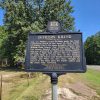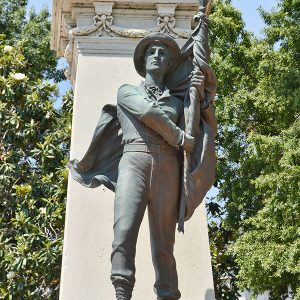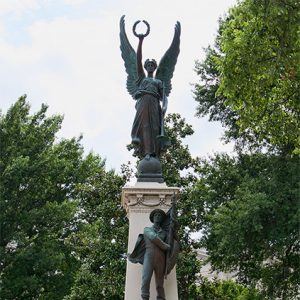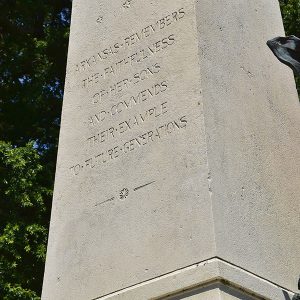calsfoundation@cals.org
Confederate Soldiers Monument
aka: "Defending the Flag," Arkansas Sons of the Confederacy Memorial
The Confederate Soldiers Monument is a commemorative sculpture erected in 1905 on the grounds of the Arkansas State Capitol in Little Rock (Pulaski County) to honor the Arkansas men who served in the Confederate army during the Civil War.
It took nearly twenty years for the Confederate Soldiers Monument to go from concept to reality. The Ladies Memorial Association in Little Rock began the effort in 1886 and continued it ten years later when the association became the Memorial Chapter of the United Daughters of the Confederacy (UDC). Fundraising got a big boost in 1897 when Arkansas Gazette president J. N. Smithee, a Confederate veteran, became involved and brought the newspaper’s resources to bear on the project. The Arkansas General Assembly appropriated $5,000 for the monument in 1903, which—when combined with the $1,200 raised through the Gazette and around $3,800 amassed through the efforts of the UDC, United Confederate Veterans (UCV), and Sons of Confederate Veterans (SCV)—provided the needed $10,000 for the monument.
The monument’s sponsors selected sculptor Frederick Ruckstuhl to design and sculpt the monument. Ruckstuhl was born in Alsace, France, in 1853, and moved to St. Louis, Missouri, with his family in 1855. Ruckstuhl studied sculpture in his home country and gained fame in the United States after winning the grand medal for sculpture at the 1893 World Columbian Exposition, which garnered him a number of high-profile commissions, including the one in Little Rock.
The monument was originally scheduled to be dedicated on May 5, 1905, but heavy rains forced a postponement, though speeches were made in the Arkansas House of Representatives Chamber at the Old State House and Confederate flags were placed on the speaker’s desk. The celebration was moved to June 3, the birthday of Jefferson Davis, who had served as president of the Confederate States of America.
More than 3,000 people attended the dedication ceremony, which started with a parade from 2nd and Center streets to the unfinished Arkansas State Capitol. Led by the band of the Second Regiment of U.S. troops from Fort Roots, the parade included Confederate veterans, UDC members, young women representing each of the seceded states, and numerous dignitaries. Former state representative Roy D. Campbell, who had sponsored the legislative appropriation for the statue, presented the monument to Governor Jeff Davis after a red-and-white cloth was removed to unveil it as the band played “Dixie.” Davis proclaimed that “at this altar we each…pay our devotions and make our offerings to the cause we each know was right, the cause of the Confederacy.” Senator James Berry presented to UDC representatives Confederate battle flags that had been returned from U.S. custody by an act of Congress, and former Confederate colonel Asa S. Morgan gave the featured oration, saying that “the Confederate cause…is not a lost cause, nor will the Confederate soldier be forgotten” because their “heroic courage…beat back from their homes and firesides the serried ranks of their ruthless and overwhelming invaders.” The ceremony concluded with a speech by former Confederate General William L. Cabell, commander of the United Confederate Veterans Trans-Mississippi Department.
The Confederate Soldiers Monument is a five-tiered construction with a twelve-foot bronze angel holding a wreath at the top and an eight-foot bronze soldier carrying a flag at its front. Both were sculpted by Ruckstuhl and cast in the A. Durenne Foundry in Paris. The marble and granite base stands nineteen feet tall. The east side of the base is inscribed “CONFEDERATE SOLDIERS OF ARKANSAS / 1861 – 1865.” The north side is inscribed “OUR FURLED BANNER / WREATHED WITH GLORY / AND THOUGH CONQUERED / WE ADORE IT / WEEP FOR THOSE / WHO FELL BEFORE IT / PARDON THOSE WHO / TRAILED AND TORE IT.” The south side is inscribed “ARKANSAS REMEMBERS / THE FAITHFULNESS / OF HER SONS / AND COMMENDS / THEIR EXAMPLE / TO FUTURE GENERATIONS.” The west side is carved with the Confederate states’ logo and inscribed “THE CONFEDERATE STATES OF AMERICA FEB 1862 DEO VINDICE.” (The last is a Latin phrase meaning “with God as our protector.”)
The Confederate Soldiers Monument was originally located on a knoll near the east entrance to the capitol building, but construction photos show that it was moved to its current location on the northeast corner of Woodlane and 4th Street by 1911. The bronze sculptures were treated in the mid-1970s, which damaged their natural patina. Sculptures and bases were restored in 2004.
The Confederate Soldiers Monument is the focal point of the annual Confederate Memorial Day observance in Arkansas, which is held on the last Monday of May each year. The monument was listed on the National Register of Historic Places on April 26, 1996.
For additional information:
Dodson, Mrs. Thomas F. “Confederate Monuments and Markers in Arkansas.” Arkansas Division UDC, 1960.
Logan, Charles Russell. “Something So Dim It Must Be Holy”: Civil War Commemorative Sculpture in Arkansas, 1886–1934. Little Rock: Arkansas Historic Preservation Program, 1996. Online at https://www.arkansasheritage.com/arkansas-preservation/programs/publications (accessed April 18, 2024).
Moneyhon, Carl H. “Conflicting Civil War Historical Memory and Cultural Divides in Arkansas.” In Competing Memories: The Legacy of Arkansas’s Civil War, edited by Mark K. Christ. Little Rock: Butler Center Books, 2016.
Slater, John. “Confederate Soldiers Monument” National Register of Historic Places registration form. On file at Arkansas Historic Preservation Program, Little Rock, Arkansas. Online at https://www.arkansasheritage.com/arkansas-historic-preservation-program (accessed April 18, 2024).
Mark K. Christ
Arkansas Historic Preservation Program
 Civil War Markers and Memorials
Civil War Markers and Memorials Early Twentieth Century, 1901 through 1940
Early Twentieth Century, 1901 through 1940 Historic Preservation
Historic Preservation Confederate Soldiers Memorial Detail
Confederate Soldiers Memorial Detail  Confederate Soldiers Memorial
Confederate Soldiers Memorial  Confederate Soldiers Monument Inscription
Confederate Soldiers Monument Inscription  Confederate Soldiers Monument Inscription
Confederate Soldiers Monument Inscription 



Comments
No comments on this entry yet.